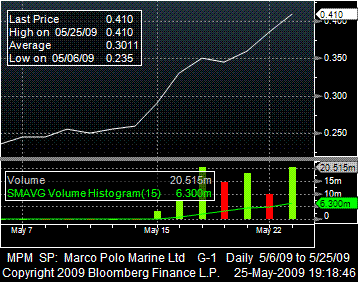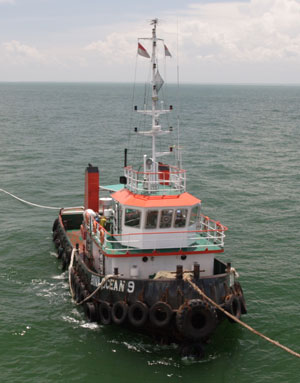
Stock started moving in mid May.
From thin trades at 26 cents or less during the first two weeks of May and for many months before that, it leapt into action after its CEO, Sean Lee, presented his optimistic views at a SIAS Research seminar held on 7 May.
Yesterday evening, it closed at 41 cents on heavy trading volumes exceeding 20 million shares.
According to Mr Lee, charter rates are pretty stable for Marco Polo’s tug-and-barge operations right now.
”The demand for tugs and boats is as high as during the boom time,” he said.
The CEO himself was surprised at how their charter rates have held up, in stark contrast to UOB Kayhian marine analyst Nancy Wei’s view that shipping stocks will remain in the doldrums.
”Investors will start to differentiate the real recovery stocks over the current quarter and the next as companies continue to post losses,” commented Ms Wei.
| Marine Transportation Stocks | Operating margin (%) | CY2Q09 profit (S$ million) |
Quarter-on- quarter growth |
YTD total stock return (%) |
| NOL | 1.6 | -244.6 | 65% | 27.7 |
| SAMUDERA SHIPPING | 7.0 | -1.1 | -123% | 83.4 |
| MARCO POLO MARINE | 16.2 | 3.2 | 144% | 84.1 |
| FIRST SHIP LEASE | 26.6 | 1.5 | 233% | 6.2 |
| SINGAPORE SHIPPING | 35.6 | -3.1 | -1% | 40.5 |
| SWISSCO | 36.0 | 5.4 | -7% | 66.2 |
| MERCATOR LINES | 48.7 | 14.6 | 12% | 158.6 |
| RICKMERS MARITIME | 55.6 | 11.0 | 54% | 34.9 |
| PACIFIC SHIPPING | 62.7 | 6.6 | 4% | 62.7 |
Data source: Bloomberg

A Marco Polo tug
Marco Polo’s revenues for 1H09 (6-months ended Mar 09) grew 46% year-on-year to S$24.0 million.
Its net earnings, however, contracted 17% to S$4.5 million, as non core operating income in 1H08 was bumped up by a one-time procurement income of S$1.4 million for securing 16 vessels for its JV; as well as a gain on disposal of 8 vessels.
It also incurred higher manpower costs, depreciation charges for its two drydocks, and finance costs incurred as a result of expanding its yard operations in 1H09.
The problem with most shipping stocks is a vessel supply glut, brought about by the past 4 years of shipbuilding boom and boom-time orders lasting into 2010.
Mr Lee, however, is grateful that the Singapore government is increasing its construction spending to S$18 billion to S$20 billion in 2009.
”A lot of construction work has been brought forward, which means a lot of construction materials have to be brought here. They have to be carried by tugs and barges,” he said.
Construction demand expanded more than for other sectors, according 1Q09 GDP figures from the Ministry of Trade and Industry released last Thu (21 May).
The sector grew 9.6% quarter-on-quarter, compared to a 14.6% contraction of Singapore’s 1Q09 GDP.
Expectations of strong construction-led demand may have attracted punters in the week leading up to MTI's data release.







